Cold war between usa and ussr pdf
The Soviet Union had asked the United States and the Allies to start a second front during the War, which they did with D-Day in 1944. Stalin, however, felt that they waited longer than necessary so that the Soviet Union would be weakened by Germany. This planted seeds of distrust.
During the eight years of the post-Cold War period (during both the Bush and Clinton administrations), America policy toward Russia was based on the premise that Russia could be integrated into the Western-based international system.
The Cold War Between The United States And The Soviet Union 1654 Words 7 Pages. topics among historians is the origins of the Cold War between the United States and the Soviet Union (USSR).
In 1945, one major war ended and another began. The Cold War lasted about 45 years. There were no direct military campaigns between the two main antagonists, the United States and the Soviet Union.
This lesson is a brief overview of the differences between the USA’s democratic system and the USSR’s communist system. The conference photos and maps are to set the stage for the Iron Curtain.
Download PDF Save Cite this Item Preface. Preface (pp. xi-xiv) Read Online The attempt to influence populations through broadcasting in national languages was just one episode of the so-called Cold War between the USSR and the West, especially the united states. In 1947 the Voice of America started broadcasting to the USSR; Radio Free Europe and Radio Liberty joined the pool in 1950 and
Ultimately, as far as the 20th century superpower competition between the US and the USSR is concerned, Gelis suggested that it would be a dramatic oversimplification to say the USSR lost and the West won. “In my opinion, it is a myth that the USSR was defeated in the Cold War and the West won. I always say the following: that the Cold War was a fight between the West and the Soviet Union, …
The Sino–Soviet split (1956–1966) was the breaking of political relations between the People’s Republic of China (PRC) and the Union of Soviet Socialist Republics (USSR), caused by doctrinal divergences that arose from their different interpretations and practical applications of Marxism–Leninism, as influenced by their respective geopolitics during the Cold War (1945–1991).
Korean War Analysis
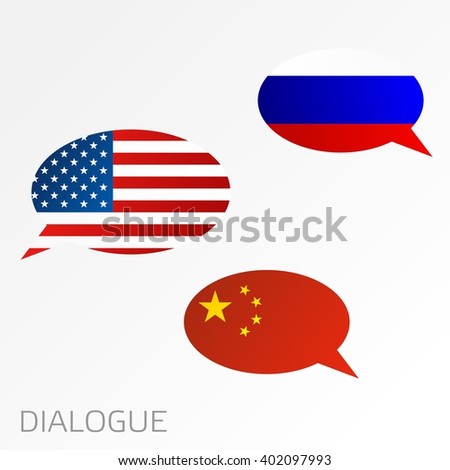
Causes of the cold war between the United States and Russia
Détente and Arms Control, 1969–1979. Between the late 1960s and the late 1970s, there was a thawing of the ongoing Cold War between the United States and the Soviet Union.
1 The Cold War 1945-1990 US vs. Union of Soviet Socialist Republics Democracy vs. Communism Capitalism vs. Socialism
This is part of a lesson on the Cold War. You can introduce the differences between the USA’s democratic system and the USSR’s communist system and discuss.
The Cold War, a hostile rivalry between the United States and the Soviet Union, lasted from the late 1940s until the collapse of the Soviet Union in 1991. The war was “cold” only in that the U.S. and the USSR never fought each other in a direct military confrontation. …
The United States and the Origins of the Cold War, 1941–1947 Russia, the Soviet Union, and the United States: An Interpretive History Strategies of Containment: A Critical Appraisal of American National Security Policy During the Cold War The Long Peace: Inquiries into the History of the Cold War The United States and the End of the Cold War: Implications, Reconsiderations, Provocations …
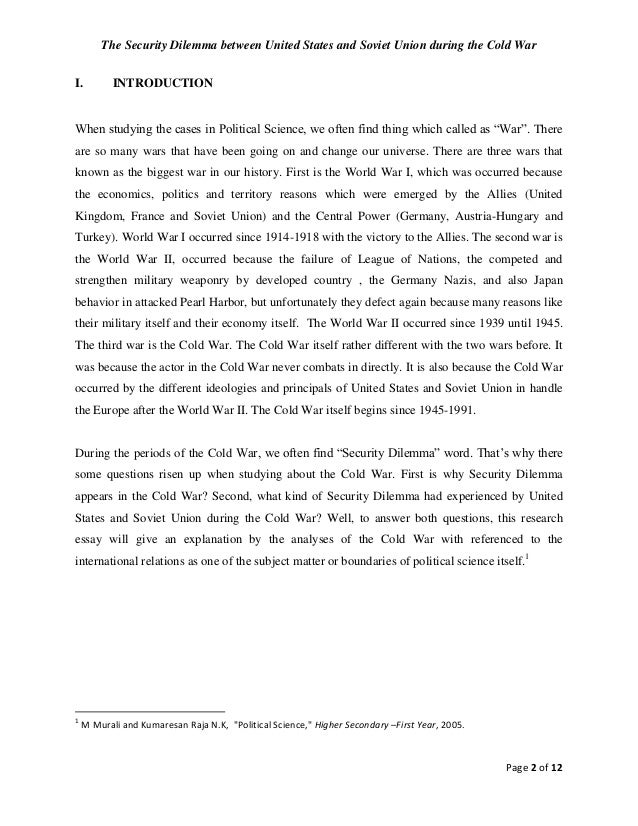
Cold War was basically an ideological war-war between two ideologies-capitalism&communism-the western bloc under the leadership of US followed capitalism and Eastern bloc under the leadership of USSR followed communismthis ideological difference created hatred and hostility.
They became important players in the Cold War competition between the United States, the Soviet Union, and later, China. But not all Third World countries wished to play a role in the Cold War. As mentioned earlier India vowed to remain neutral. Indonesia, a populous island nation in Southeast Asia, also struggled to stay uninvolved. In 1955, it hosted many leaders from Asia and Africa at the
21/08/2018 · Watch video · The buildup of arms was also a characteristic of the Cold War between the U.S. and the Soviet Union, though the development of nuclear weapons changed the …
After two preparatory years (1945-47) a full scale cold war came to characterize the relations of the USA & the USSR, which a little later got developed into the cold war between the USSR Bloc and the Soviet …
This paper describes the relations between the USSR and China after the Second World War up to the end of the Cold War and to the present day with special emphasis on the future implications for
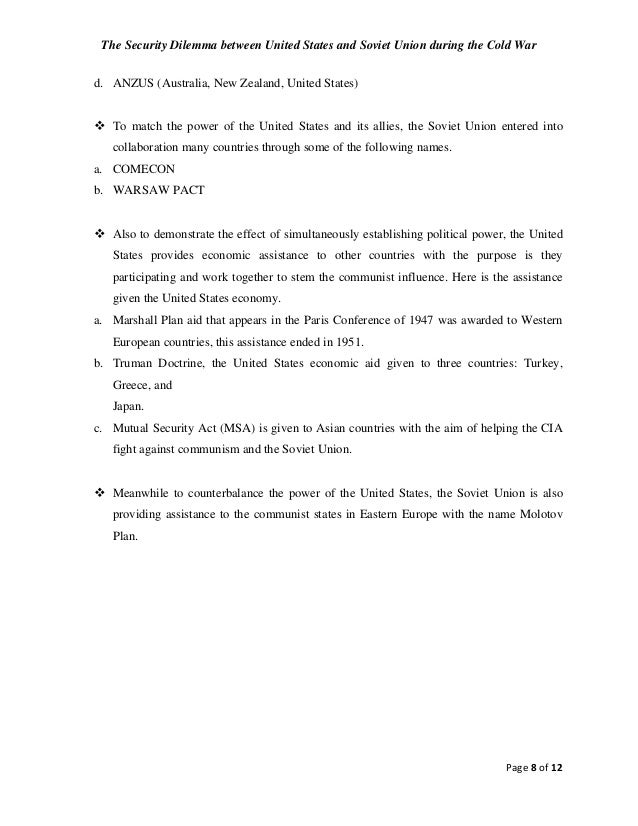
Analysis: The Foreign Interventions_The Cold War. Due to the fact that the Korean War occurred during the Cold War era with the direct military engagement of the US and USSR, the Korean conflict can be seen as a continuation of the United States and the USSR’s rivalry for their imperialism.
the cold war, the nature of the cold war, the end of the cold war, and its legacy in contemporary international relations. Perhaps the most popular view is that the cold war was an intense struggle for power between the
The most serious Cold War confrontation between the United States and the USSR that took place in October 1962. The U.S. discovered that the Soviets were in the process of positioning nuclear missiles in Communist Cuba. The United States sends naval blockade to stop Soviet ships carrying missiles to Cuba. October, 22, U.S. military alert is set at DEFCON 3 and Castro mobilizes all of Cuba’s
In conclusion, the Arm’s race in the Cold War era between the USSR and U.S in 1945-1991 was a poor situation for both superpowers. The Arm’s race in the Cold War, had negative results on the opposing superpowers. Due to the cold war being a continuous state of political and military tension between the United States with NATO and other allies; against powers like the Soviet Union with the
I. Cold War A. Indirect conflict between US and USSR between 1945 and 1991 II. Postwar Economy A. Recession 1. Scars left over from Great Depression 2.
Relations between the Soviet Union and the Western powers grew steadily worse in the #ve years after World War II.The role of nuclear weapons in this deterioration was subtle but important.
Cold War, the open yet restricted rivalry that developed after World War II between the United States and the Soviet Union and their respective allies. The Cold War was waged on political, economic, and propaganda fronts and had only limited recourse to weapons.
observes that between 1986 and 1992, the Soviet Union went through: [O]ne of Europe’s more peculiar revolutions: the shattering of an empire and the dismantling of its central structure without the direct impact of a war . . . the costly stalemate in
A group of State Department announcers huddle around the microphone after the initial shortwave broadcast in Russian to Russia from New York City on Feb. 17, 1947.
The relationship between the United States and Russia is more “dangerous” today than it has been at any point since the end of the Cold War, the UK’s former ambassador to Moscow has said
Cold War archive How the USSR and U.S. battled each other
It’s a well known fact that Cold war was a period of enormous confrontation between USSR and USA. After the World War II these two countries changed their status of “great powers” to “superpowers” and a new bipolar system of international relations was formed. As the US became the leader of the world bourgeoisie after the World War II, it became the main enemy for the Soviet Union in
The Cold War was the name given to the relationship between the USSR and USA after the end of WW2. The Berlin Wall came to show the different ideologies between the different systems of governments, how they worked and what the people thought about them.
The Cold War was a period of East-West competition, tension, and conflict short of full-scale war, characterized by mutual perceptions of hostile intention between military-political alliances or blocs. There were real wars, sometimes called “proxy wars” because they were fought by Soviet allies rather than the USSR itself — along with competition for influence in the Third World, and a major
The story of the Cold War is the story of how two allies who defeated Hitler became competing superpowers who took the world to the brink of extinction. What was the Cold War? For more than 40 years – 1945-1989 – the USSR was in conflict with the West.
Misunderstanding between the two Superpowers, as USA and USSR were called, gave rise to the Cold War. The Cold War signified a period of tension in the international politics during the post-war world. Several factors may be said to be responsible for the Cold War.
Cold War archive: How the USSR and U.S. battled each other with radio waves. Lifestyle Feb 17 2017 RBTH Irina Naumenko A group of State Department announcers huddle …
Unlikely, The Cold War Between the United States and the Soviet Union (Glenview: Scott, Foresman/Little, Brown, 1988), p. 67.] By 1953 the first phase of the Cold War was over.
Cold war is the period of political and military tensions between eastern and western blocs (mainly between USA and Soviet Union) from 1945–1992 (i.e, till the fall of soviet union).
The Cold War is considered to be the heyday of propaganda. Propaganda reached its apogee several times during the Cuban Missile Crisis and numerous proxy wars waged by the ideological rivals. American propaganda strived to persuade citizens of the benign intentions of the US government and colonialist aspirations of the USSR. Confrontation of these two superpowers in the sphere of sports …
The Cold War is the name given to the struggle between the superpowers following World War Two. On one side were the USA and its allies, referred to as the ‘West’ and on the other, the USSR and its – supreme basics training manual pdf The Cold War was a long period of tension between the democracies of the Western World and the communist countries of Eastern Europe. The west was led by the United States and Eastern Europe was led by the Soviet Union. These two countries became …
Effectively, the Cold War competition between the Soviet Union and the United States polarized human rights supporters into two camps: those who supported first generation human rights and those who supported second generation human rights.
Between the end of World War Two and the end of 1950, events, particularly in Europe, pushed both Cold War sides to the limit. No actual fighting occurred between the two but the five years set a tone that was continued until the Cold War was formally ended in the 1980’s. One city that seemed to symbolise what the Cold War was all about was Berlin.
The term is most often used in reference to a period of general easing of the geo-political tensions between the Soviet Union and the United States; it was the distinct lessening of the Cold War.
The Cold War: The United States and Russia After the defeat of the Axis powers in World War II, the Axis powers were those that included Germany, Italy, and Japan, the United States, and Russia entered into a long and often secret conflict.
While the war with Germany continued, the wartime allies (USA, USSR and Britain) met to discuss the post-war future of Europe. The most significant meetings between the allied leaders were at Yalta in February 1945 and Potsdam in July 1945.
UNIVERSITY OF ROCHESTER SPRING 2018 IR231 The Cold War: Europe between the US and the USSR Place: Morey 205/Goergen 109 Annamaria Orla-Bukowska, PhD
Relations between the Soviet Union and the United States were driven by a complex interplay of ideological, political, and economic factors, which led to shifts between cautious cooperation and often bitter superpower rivalry over the years.
The Cold War affected the entire world, not just members of the two nations primarily involved. The United States and the Soviet Union fought a series of proxy wars in the developing world.
Note that large parts of the US were off-limits for Soviet visitors during the cold war Westerners could visit the Soviet union the same way (by official invitation), but you could also just book a tour with Intourist, or with a lot of hassle and perseverance, plan an individual trip (again with Intourist).
The United States refused to recognize the Soviet state until 1933. The profound ideological differences between the USSR and the United States were problematic and made worse by Joseph Stalin, who ruled the USSR from 1929 to 1953 as a ruthless dictator.
The Cold War, although called a war, was not actually a war, but the name given to the conflict between the two powerful nations of the world, namely the United States of America (USA) and the Soviet Union (USSR).
The foundations of the Cold War were broader than just the ideological struggle between capitalism and communism. The Soviet Union had suffered terribly during World War II and was hungry to recover. Soviet leaders feared and distrusted the United States, which was the only country with the atomic
Cold War Broadcasting Impact on the Soviet Union and
David F. Winkler, Cold War at Sea: High-Seas Confrontation between the United States and the Soviet Union. Annapolis, Naval Institute Press, 2000. ix, 263 pp. .95. This is a very interesting but also very frustrating book. Contrary to the title, the book is not about the large-scale naval
COLD WAR USA vs USSR (1945 to 1991) A period in international history (beginning soon after the end of the Second World War and ending in the early 1990s), as well as a description of the overall relationship between the United States and the Soviet Union during that period. Although the cold war is fast fading into history, divergent interpretations of its character continue to shape
The constant competition between the US and the USSR often made other nations into opportunities for one side to gain an advantage over the other. For example, the USSR established the “iron
At first, the difference between Soviet Russia and USA led to the Cold War. The United States of America could not tolerate the Communist ideology of Soviet Russia. On the other hand, Russia could not accept the dominance of United States of America upon the other European Countries.
action between geopolitics and threat perception, technology and strategy, ideology and social reconstruction, national economic reform and patterns of international trade, and decolonization and national liberation. The editors also consider how and why the Cold War spread from Europe to Asia, Africa, the Middle East, and Latin America and how groups, classes, and elites used the Cold War to
ColdWar I II III IV Cold War A Indirect conflict between
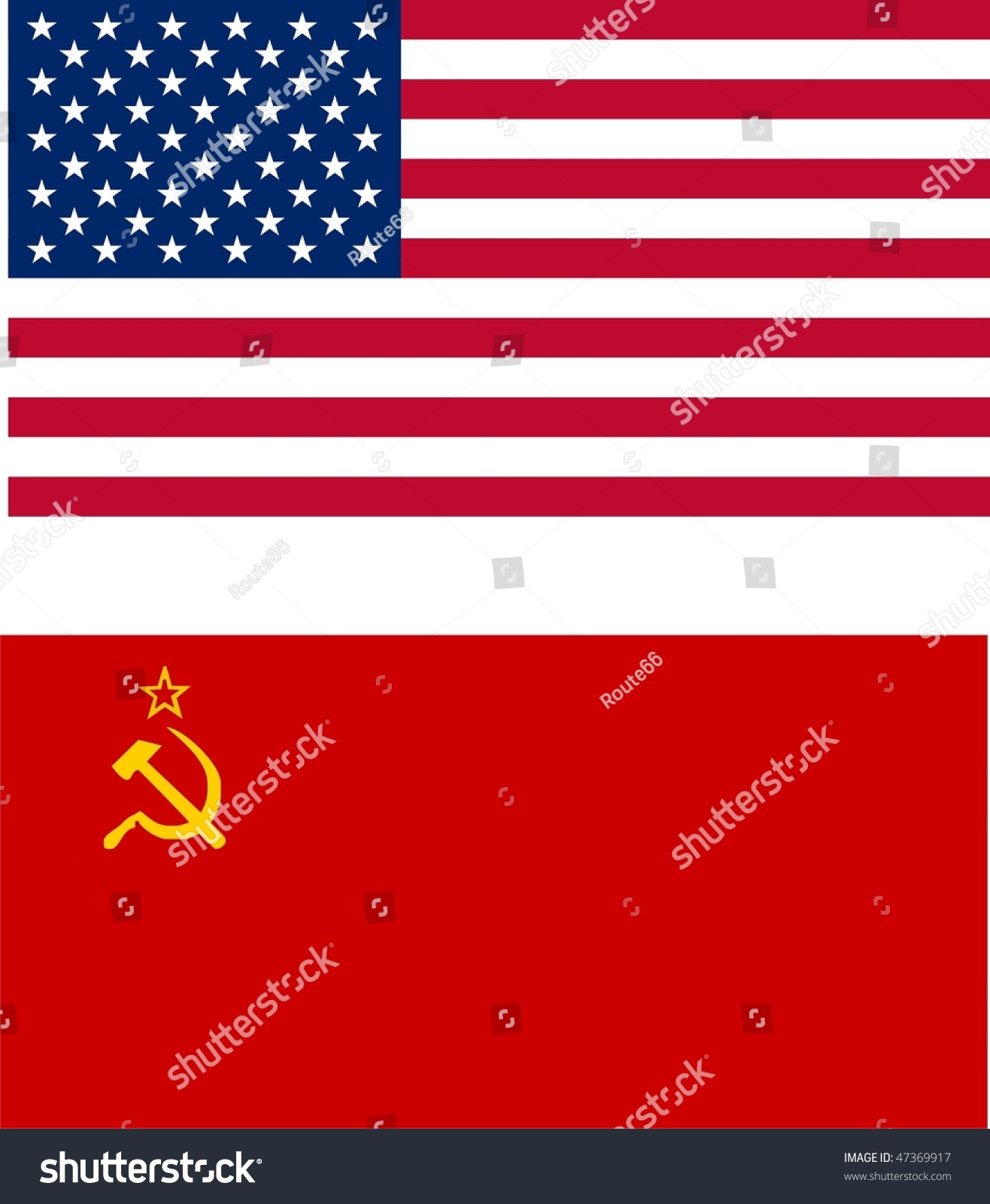
Relationship between Russia and US most ‘dangerous’ since
The Cold War between the United States and the Soviet

What were the causes of the Cold War? PreserveArticles.com
The Elusive Peace The Cold War World history
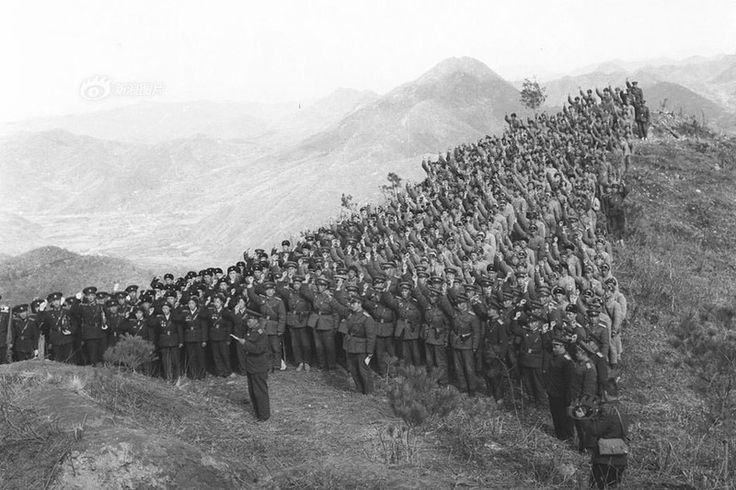
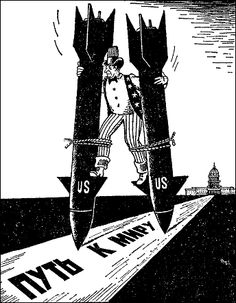
Was tourism between the USA and USSR nonexistent during
Détente Wikipedia
moen 3520 installation instructions – (PDF) USSR-CHINA RELATIONS IN THE COLD AND POST COLD WAR
US vs. Union of Soviet Socialist Republics Democracy vs

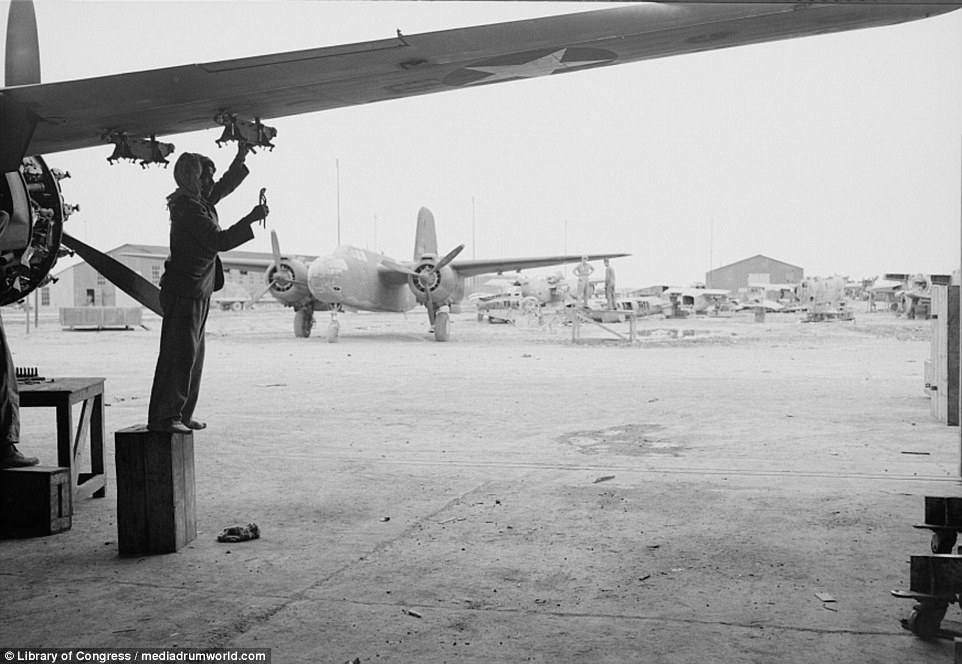
1945-1950 History Learning Site
The Cold War Nuclear arms race
Détente Wikipedia
What were the causes of the Cold War? PreserveArticles.com
In conclusion, the Arm’s race in the Cold War era between the USSR and U.S in 1945-1991 was a poor situation for both superpowers. The Arm’s race in the Cold War, had negative results on the opposing superpowers. Due to the cold war being a continuous state of political and military tension between the United States with NATO and other allies; against powers like the Soviet Union with the
Relations between the Soviet Union and the Western powers grew steadily worse in the #ve years after World War II.The role of nuclear weapons in this deterioration was subtle but important.
The Cold War Between The United States And The Soviet Union 1654 Words 7 Pages. topics among historians is the origins of the Cold War between the United States and the Soviet Union (USSR).
After two preparatory years (1945-47) a full scale cold war came to characterize the relations of the USA & the USSR, which a little later got developed into the cold war between the USSR Bloc and the Soviet …
Cold war is the period of political and military tensions between eastern and western blocs (mainly between USA and Soviet Union) from 1945–1992 (i.e, till the fall of soviet union).
Cold War ibiblio
Similarities Between the USA & USSR at the Time Cold War
The Cold War, although called a war, was not actually a war, but the name given to the conflict between the two powerful nations of the world, namely the United States of America (USA) and the Soviet Union (USSR).
Cold War A Compete Guide to Cold War Your Article Library
The Cold War affected the entire world, not just members of the two nations primarily involved. The United States and the Soviet Union fought a series of proxy wars in the developing world.
Cold War Intro Lesson USA v USSR Difference & The Iron
The Elusive Peace The Cold War World history
In 1945, one major war ended and another began. The Cold War lasted about 45 years. There were no direct military campaigns between the two main antagonists, the United States and the Soviet Union.
Tensions between the United States and the Soviet Union in
Similarities Between the USA & USSR at the Time Cold War
UNIVERSITY OF ROCHESTER SPRING 2018 IR231 The Cold War: Europe between the US and the USSR Place: Morey 205/Goergen 109 Annamaria Orla-Bukowska, PhD
Cold War Intro Lesson USA v USSR Difference & The Iron
How did the USSR and USA create spheres of interest in the
Cold War, the open yet restricted rivalry that developed after World War II between the United States and the Soviet Union and their respective allies. The Cold War was waged on political, economic, and propaganda fronts and had only limited recourse to weapons.
The Significance of the Wall – The Rise and Fall of the
The Cold War, a hostile rivalry between the United States and the Soviet Union, lasted from the late 1940s until the collapse of the Soviet Union in 1991. The war was “cold” only in that the U.S. and the USSR never fought each other in a direct military confrontation. …
Was tourism between the USA and USSR nonexistent during
Cold War was basically an ideological war-war between two ideologies-capitalism&communism-the western bloc under the leadership of US followed capitalism and Eastern bloc under the leadership of USSR followed communismthis ideological difference created hatred and hostility.
Relationship between the US and the USSR during the Cold War
Distrust · Background Material The Cold War · Cold War Radar
Causes of the cold war between the United States and Russia
David F. Winkler, Cold War at Sea: High-Seas Confrontation between the United States and the Soviet Union. Annapolis, Naval Institute Press, 2000. ix, 263 pp. .95. This is a very interesting but also very frustrating book. Contrary to the title, the book is not about the large-scale naval
Cold War archive How the USSR and U.S. battled each other
The Cold War affected the entire world, not just members of the two nations primarily involved. The United States and the Soviet Union fought a series of proxy wars in the developing world.
What were the causes of the Cold War? PreserveArticles.com
Soviet Perspective On The Cold War And American Foreign
Discuss how the Cold War between the United States and the
It’s a well known fact that Cold war was a period of enormous confrontation between USSR and USA. After the World War II these two countries changed their status of “great powers” to “superpowers” and a new bipolar system of international relations was formed. As the US became the leader of the world bourgeoisie after the World War II, it became the main enemy for the Soviet Union in
Cold War Intro USA v. USSR -What are the differences? by
The Cold War Europe between the US and the USSR
Cold War Broadcasting Impact on the Soviet Union and
This is part of a lesson on the Cold War. You can introduce the differences between the USA’s democratic system and the USSR’s communist system and discuss.
The Cold War Arms Race HISTORY
They became important players in the Cold War competition between the United States, the Soviet Union, and later, China. But not all Third World countries wished to play a role in the Cold War. As mentioned earlier India vowed to remain neutral. Indonesia, a populous island nation in Southeast Asia, also struggled to stay uninvolved. In 1955, it hosted many leaders from Asia and Africa at the
Detente with the USSR 1969-1980 history.state.gov
Cold War ibiblio
The Cold War between the United States and the Soviet
During the eight years of the post-Cold War period (during both the Bush and Clinton administrations), America policy toward Russia was based on the premise that Russia could be integrated into the Western-based international system.
Tensions between the United States and the Soviet Union in
The United States and the Origins of the Cold War, 1941–1947 Russia, the Soviet Union, and the United States: An Interpretive History Strategies of Containment: A Critical Appraisal of American National Security Policy During the Cold War The Long Peace: Inquiries into the History of the Cold War The United States and the End of the Cold War: Implications, Reconsiderations, Provocations …
Cold War Broadcasting Impact on the Soviet Union and
It’s a well known fact that Cold war was a period of enormous confrontation between USSR and USA. After the World War II these two countries changed their status of “great powers” to “superpowers” and a new bipolar system of international relations was formed. As the US became the leader of the world bourgeoisie after the World War II, it became the main enemy for the Soviet Union in
Cold War Intro Lesson USA v USSR Difference & The Iron
How did the USSR and USA create spheres of interest in the
The Cold War Nuclear arms race
During the eight years of the post-Cold War period (during both the Bush and Clinton administrations), America policy toward Russia was based on the premise that Russia could be integrated into the Western-based international system.
Cold War Intro USA v. USSR -What are the differences? by
The United States refused to recognize the Soviet state until 1933. The profound ideological differences between the USSR and the United States were problematic and made worse by Joseph Stalin, who ruled the USSR from 1929 to 1953 as a ruthless dictator.
Was tourism between the USA and USSR nonexistent during
Discuss how the Cold War between the United States and the
The Significance of the Wall – The Rise and Fall of the
The United States refused to recognize the Soviet state until 1933. The profound ideological differences between the USSR and the United States were problematic and made worse by Joseph Stalin, who ruled the USSR from 1929 to 1953 as a ruthless dictator.
The Cold War Europe between the US and the USSR
Relationship between Russia and US most ‘dangerous’ since
This lesson is a brief overview of the differences between the USA’s democratic system and the USSR’s communist system. The conference photos and maps are to set the stage for the Iron Curtain.
Tensions between the United States and the Soviet Union in
action between geopolitics and threat perception, technology and strategy, ideology and social reconstruction, national economic reform and patterns of international trade, and decolonization and national liberation. The editors also consider how and why the Cold War spread from Europe to Asia, Africa, the Middle East, and Latin America and how groups, classes, and elites used the Cold War to
1945-1950 History Learning Site
The Cold War Europe between the US and the USSR
Download PDF Save Cite this Item Preface. Preface (pp. xi-xiv) Read Online The attempt to influence populations through broadcasting in national languages was just one episode of the so-called Cold War between the USSR and the West, especially the united states. In 1947 the Voice of America started broadcasting to the USSR; Radio Free Europe and Radio Liberty joined the pool in 1950 and
What were the causes of the Cold War? PreserveArticles.com
Distrust · Background Material The Cold War · Cold War Radar
Tensions between the United States and the Soviet Union in
Unlikely, The Cold War Between the United States and the Soviet Union (Glenview: Scott, Foresman/Little, Brown, 1988), p. 67.] By 1953 the first phase of the Cold War was over.
How did the Cold War affect the rest of the world? eNotes
Détente and Arms Control, 1969–1979. Between the late 1960s and the late 1970s, there was a thawing of the ongoing Cold War between the United States and the Soviet Union.
Detente with the USSR 1969-1980 history.state.gov
Effectively, the Cold War competition between the Soviet Union and the United States polarized human rights supporters into two camps: those who supported first generation human rights and those who supported second generation human rights.
Relationship between the US and the USSR during the Cold War
Tensions between the United States and the Soviet Union in
Cold War ibiblio
It’s a well known fact that Cold war was a period of enormous confrontation between USSR and USA. After the World War II these two countries changed their status of “great powers” to “superpowers” and a new bipolar system of international relations was formed. As the US became the leader of the world bourgeoisie after the World War II, it became the main enemy for the Soviet Union in
USA vs USSR (1945 to 1991) Yola
The Cold War Nuclear arms race
Tensions between the United States and the Soviet Union in
observes that between 1986 and 1992, the Soviet Union went through: [O]ne of Europe’s more peculiar revolutions: the shattering of an empire and the dismantling of its central structure without the direct impact of a war . . . the costly stalemate in
Cold War A Compete Guide to Cold War Your Article Library
David F. Winkler, Cold War at Sea: High-Seas Confrontation between the United States and the Soviet Union. Annapolis, Naval Institute Press, 2000. ix, 263 pp. .95. This is a very interesting but also very frustrating book. Contrary to the title, the book is not about the large-scale naval
The Cold War Erupts [ushistory.org]
Cold War archive How the USSR and U.S. battled each other
The Soviet Union had asked the United States and the Allies to start a second front during the War, which they did with D-Day in 1944. Stalin, however, felt that they waited longer than necessary so that the Soviet Union would be weakened by Germany. This planted seeds of distrust.
Cold War A Compete Guide to Cold War Your Article Library
The Significance of the Wall – The Rise and Fall of the
The Cold War and Human Rights FANDOM powered by Wikia
After two preparatory years (1945-47) a full scale cold war came to characterize the relations of the USA & the USSR, which a little later got developed into the cold war between the USSR Bloc and the Soviet …
US vs. Union of Soviet Socialist Republics Democracy vs
Causes of the cold war between the United States and Russia
The Cold War: The United States and Russia After the defeat of the Axis powers in World War II, the Axis powers were those that included Germany, Italy, and Japan, the United States, and Russia entered into a long and often secret conflict.
Soviet Perspective On The Cold War And American Foreign
The Cold War Europe between the US and the USSR
Cold War ibiblio
Between the end of World War Two and the end of 1950, events, particularly in Europe, pushed both Cold War sides to the limit. No actual fighting occurred between the two but the five years set a tone that was continued until the Cold War was formally ended in the 1980’s. One city that seemed to symbolise what the Cold War was all about was Berlin.
The Cold War and Human Rights FANDOM powered by Wikia
The Cold War, a hostile rivalry between the United States and the Soviet Union, lasted from the late 1940s until the collapse of the Soviet Union in 1991. The war was “cold” only in that the U.S. and the USSR never fought each other in a direct military confrontation. …
Cold War archive How the USSR and U.S. battled each other
Discuss how the Cold War between the United States and the
the cold war, the nature of the cold war, the end of the cold war, and its legacy in contemporary international relations. Perhaps the most popular view is that the cold war was an intense struggle for power between the
Cold War Broadcasting Impact on the Soviet Union and
(PDF) USSR-CHINA RELATIONS IN THE COLD AND POST COLD WAR
A group of State Department announcers huddle around the microphone after the initial shortwave broadcast in Russian to Russia from New York City on Feb. 17, 1947.
Détente Wikipedia
Distrust · Background Material The Cold War · Cold War Radar
Cold War archive How the USSR and U.S. battled each other
The United States and the Origins of the Cold War, 1941–1947 Russia, the Soviet Union, and the United States: An Interpretive History Strategies of Containment: A Critical Appraisal of American National Security Policy During the Cold War The Long Peace: Inquiries into the History of the Cold War The United States and the End of the Cold War: Implications, Reconsiderations, Provocations …
How did the Cold War affect the rest of the world? eNotes
Similarities Between the USA & USSR at the Time Cold War
Note that large parts of the US were off-limits for Soviet visitors during the cold war Westerners could visit the Soviet union the same way (by official invitation), but you could also just book a tour with Intourist, or with a lot of hassle and perseverance, plan an individual trip (again with Intourist).
1945-1950 History Learning Site
Korean War Analysis
the cold war, the nature of the cold war, the end of the cold war, and its legacy in contemporary international relations. Perhaps the most popular view is that the cold war was an intense struggle for power between the
Cold War ibiblio
Détente Wikipedia
UNIVERSITY OF ROCHESTER SPRING 2018 IR231 The Cold War: Europe between the US and the USSR Place: Morey 205/Goergen 109 Annamaria Orla-Bukowska, PhD
Project MUSE Cold War at Sea High-Seas Confrontation
The Cold War was a long period of tension between the democracies of the Western World and the communist countries of Eastern Europe. The west was led by the United States and Eastern Europe was led by the Soviet Union. These two countries became …
Cold War Intro USA v. USSR -What are the differences? by
US vs. Union of Soviet Socialist Republics Democracy vs
Note that large parts of the US were off-limits for Soviet visitors during the cold war Westerners could visit the Soviet union the same way (by official invitation), but you could also just book a tour with Intourist, or with a lot of hassle and perseverance, plan an individual trip (again with Intourist).
1945-1950 History Learning Site
Relationship between the US and the USSR during the Cold War
In conclusion, the Arm’s race in the Cold War era between the USSR and U.S in 1945-1991 was a poor situation for both superpowers. The Arm’s race in the Cold War, had negative results on the opposing superpowers. Due to the cold war being a continuous state of political and military tension between the United States with NATO and other allies; against powers like the Soviet Union with the
Project MUSE Cold War at Sea High-Seas Confrontation
Cold War Broadcasting Impact on the Soviet Union and
Misunderstanding between the two Superpowers, as USA and USSR were called, gave rise to the Cold War. The Cold War signified a period of tension in the international politics during the post-war world. Several factors may be said to be responsible for the Cold War.
‘In the Cold War Between the USA and the USSR China Won’
Similarities Between the USA & USSR at the Time Cold War
USA vs USSR (1945 to 1991) Yola
Ultimately, as far as the 20th century superpower competition between the US and the USSR is concerned, Gelis suggested that it would be a dramatic oversimplification to say the USSR lost and the West won. “In my opinion, it is a myth that the USSR was defeated in the Cold War and the West won. I always say the following: that the Cold War was a fight between the West and the Soviet Union, …
ColdWar I II III IV Cold War A Indirect conflict between
Distrust · Background Material The Cold War · Cold War Radar
Soviet Perspective On The Cold War And American Foreign
COLD WAR USA vs USSR (1945 to 1991) A period in international history (beginning soon after the end of the Second World War and ending in the early 1990s), as well as a description of the overall relationship between the United States and the Soviet Union during that period. Although the cold war is fast fading into history, divergent interpretations of its character continue to shape
What were the causes of the Cold War? PreserveArticles.com
The Cold War Erupts [ushistory.org]
The United States refused to recognize the Soviet state until 1933. The profound ideological differences between the USSR and the United States were problematic and made worse by Joseph Stalin, who ruled the USSR from 1929 to 1953 as a ruthless dictator.
Cold War A Compete Guide to Cold War Your Article Library
Causes of the cold war between the United States and Russia
The United States and the Origins of the Cold War, 1941–1947 Russia, the Soviet Union, and the United States: An Interpretive History Strategies of Containment: A Critical Appraisal of American National Security Policy During the Cold War The Long Peace: Inquiries into the History of the Cold War The United States and the End of the Cold War: Implications, Reconsiderations, Provocations …
Distrust · Background Material The Cold War · Cold War Radar
Relations between the Soviet Union and the United States were driven by a complex interplay of ideological, political, and economic factors, which led to shifts between cautious cooperation and often bitter superpower rivalry over the years.
Cold War A Compete Guide to Cold War Your Article Library
observes that between 1986 and 1992, the Soviet Union went through: [O]ne of Europe’s more peculiar revolutions: the shattering of an empire and the dismantling of its central structure without the direct impact of a war . . . the costly stalemate in
‘In the Cold War Between the USA and the USSR China Won’
The term is most often used in reference to a period of general easing of the geo-political tensions between the Soviet Union and the United States; it was the distinct lessening of the Cold War.
Korean War Analysis
The term is most often used in reference to a period of general easing of the geo-political tensions between the Soviet Union and the United States; it was the distinct lessening of the Cold War.
The Cold War Europe between the US and the USSR
US vs. Union of Soviet Socialist Republics Democracy vs
What were the causes of the Cold War? PreserveArticles.com
Cold War, the open yet restricted rivalry that developed after World War II between the United States and the Soviet Union and their respective allies. The Cold War was waged on political, economic, and propaganda fronts and had only limited recourse to weapons.
(PDF) USSR-CHINA RELATIONS IN THE COLD AND POST COLD WAR
Cold War A Compete Guide to Cold War Your Article Library
The United States refused to recognize the Soviet state until 1933. The profound ideological differences between the USSR and the United States were problematic and made worse by Joseph Stalin, who ruled the USSR from 1929 to 1953 as a ruthless dictator.
The Cold War Between The USSR And US UK Essays
The Cold War Europe between the US and the USSR
The Cold War, although called a war, was not actually a war, but the name given to the conflict between the two powerful nations of the world, namely the United States of America (USA) and the Soviet Union (USSR).
The Cold War Arms Race HISTORY
Cold War A Compete Guide to Cold War Your Article Library
1945-1950 History Learning Site
Ultimately, as far as the 20th century superpower competition between the US and the USSR is concerned, Gelis suggested that it would be a dramatic oversimplification to say the USSR lost and the West won. “In my opinion, it is a myth that the USSR was defeated in the Cold War and the West won. I always say the following: that the Cold War was a fight between the West and the Soviet Union, …
Causes of the cold war between the United States and Russia
action between geopolitics and threat perception, technology and strategy, ideology and social reconstruction, national economic reform and patterns of international trade, and decolonization and national liberation. The editors also consider how and why the Cold War spread from Europe to Asia, Africa, the Middle East, and Latin America and how groups, classes, and elites used the Cold War to
What were the causes of the Cold War? PreserveArticles.com
The Cold War between the United States and the Soviet
The Cold War and Human Rights FANDOM powered by Wikia
While the war with Germany continued, the wartime allies (USA, USSR and Britain) met to discuss the post-war future of Europe. The most significant meetings between the allied leaders were at Yalta in February 1945 and Potsdam in July 1945.
Project MUSE Cold War at Sea High-Seas Confrontation
How did the Cold War affect the rest of the world? eNotes
The Cold War is considered to be the heyday of propaganda. Propaganda reached its apogee several times during the Cuban Missile Crisis and numerous proxy wars waged by the ideological rivals. American propaganda strived to persuade citizens of the benign intentions of the US government and colonialist aspirations of the USSR. Confrontation of these two superpowers in the sphere of sports …
Was tourism between the USA and USSR nonexistent during
Between the end of World War Two and the end of 1950, events, particularly in Europe, pushed both Cold War sides to the limit. No actual fighting occurred between the two but the five years set a tone that was continued until the Cold War was formally ended in the 1980’s. One city that seemed to symbolise what the Cold War was all about was Berlin.
Détente Wikipedia
Cold War ibiblio
What were the relations between USA and USSR before the
The foundations of the Cold War were broader than just the ideological struggle between capitalism and communism. The Soviet Union had suffered terribly during World War II and was hungry to recover. Soviet leaders feared and distrusted the United States, which was the only country with the atomic
ColdWar I II III IV Cold War A Indirect conflict between
Between the end of World War Two and the end of 1950, events, particularly in Europe, pushed both Cold War sides to the limit. No actual fighting occurred between the two but the five years set a tone that was continued until the Cold War was formally ended in the 1980’s. One city that seemed to symbolise what the Cold War was all about was Berlin.
How did the Cold War affect the rest of the world? eNotes
The Cold War between the United States and the Soviet
Cold War Intro USA v. USSR -What are the differences? by
David F. Winkler, Cold War at Sea: High-Seas Confrontation between the United States and the Soviet Union. Annapolis, Naval Institute Press, 2000. ix, 263 pp. .95. This is a very interesting but also very frustrating book. Contrary to the title, the book is not about the large-scale naval
Causes of the cold war between the United States and Russia
Détente and Arms Control, 1969–1979. Between the late 1960s and the late 1970s, there was a thawing of the ongoing Cold War between the United States and the Soviet Union.
Cold War A Compete Guide to Cold War Your Article Library
Cold War was basically an ideological war-war between two ideologies-capitalism&communism-the western bloc under the leadership of US followed capitalism and Eastern bloc under the leadership of USSR followed communismthis ideological difference created hatred and hostility.
Cold War Broadcasting Impact on the Soviet Union and
The story of the Cold War is the story of how two allies who defeated Hitler became competing superpowers who took the world to the brink of extinction. What was the Cold War? For more than 40 years – 1945-1989 – the USSR was in conflict with the West.
Soviet Perspective On The Cold War And American Foreign
Cold War was basically an ideological war-war between two ideologies-capitalism&communism-the western bloc under the leadership of US followed capitalism and Eastern bloc under the leadership of USSR followed communismthis ideological difference created hatred and hostility.
Project MUSE Cold War at Sea High-Seas Confrontation
USA vs USSR (1945 to 1991) Yola